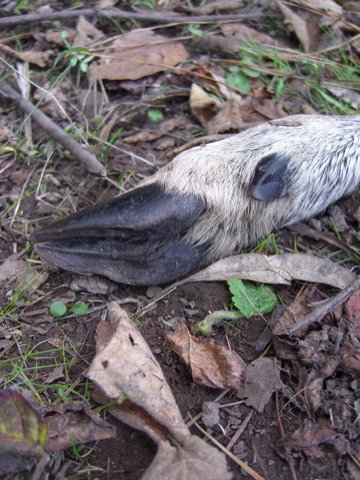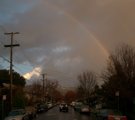[Previous post: ‘Going to a Dangerous Place‘]
A couple weeks ago I wrote a post called Going to a Dangerous Place” about a series of stories about the death of a cyclist, Kim Flint, on South Park Drive in the Berkeley Hills. In particular, I took issue with the description of Flint as “obsessed” with a socially networked training-log site called Strava, whether his concern for attaining speed records for various road segments drove him to ride dangerously on the hazardous South Park descent, and whether his death could really be blamed on the service that Strava provides. A few days ago, a Berkeley cyclist I’ve met named Patrick Gordis offered to set me straight on some of the issues I raised. What follows are his comments on some of the issues raised by this incident. Patrick posted these as a long comment on the blog, but he gave me the OK to repost it as a separate entry (and the picture below comes from him, too; I’ll post a better version later). Here’s his post:
Dan: Thank you for your thoughtful analysis of this tragic accident. I would like to add a few more details to clarify the record. First of all, I don’t know if you came across the account of his accident as reported in the Daily Cal? Note in particular the following quotes of his partner of 19 years:
Violet Hefner, Flint’s partner of 19 years, said she is “99 percent certain he was trying to regain his lost record,” the day he was killed. Hefner said they had originally started cycling together, but she thought it was too dangerous. “He knew that I was very, very afraid of him riding on city streets,” she said. “I begged him not to.” Hefner added that once Flint joined Strava, his interest in his speed and his ride statistics became more intense. “Things really escalated once he got involved with Strava,” she said. “It became an obsession with him.” Flint holds a best time of an average of 33.9 miles per hour on the “Centennial Drive Descent” in Berkeley as well as the record for the “Skyline Boulevard Descent” in Oakland with an average of 30.4 miles per hour. Hefner said Flint had been focusing more and more on getting “king of the mountain” – the highest speed for a certain stretch of road – for downhill segments over the last two months. Hefner added that though the website fueled Flint’s urge to push himself, she didn’t blame the competitive nature of Strava for his death.
 The Daily Cal story also seems to imply that Kim may have entered the sharp corner towards the upper section on South Park Drive where he sidewiped a passing car at close to 45 mph. Based on my own experience on that turn, I would say anything over 30 mph at the apex of the turn would be a difficult, if not impossible line to sustain without use of the entire road (even then, anything near 45 mph seems too fast for a turn of that kind – even for “Il Falco”). (Click picture for larger image.)
The Daily Cal story also seems to imply that Kim may have entered the sharp corner towards the upper section on South Park Drive where he sidewiped a passing car at close to 45 mph. Based on my own experience on that turn, I would say anything over 30 mph at the apex of the turn would be a difficult, if not impossible line to sustain without use of the entire road (even then, anything near 45 mph seems too fast for a turn of that kind – even for “Il Falco”). (Click picture for larger image.)
Furthermore, I had some private email exchanges with Kim the weekend before his death in which we discussed various Strava segments of a 95-mile ride we had taken together with one other cyclist. In particular, he analyzed for me why, in his view, he did not get the KOMs on the Palomares north side descent or the Joaquin Miller descent from Skyline to Mountain. From these email exchanges, from conversations I had with him about Strava on our rides and from observing him descending, it’s clear to me that he was very focused on obtaining Strava downhill records and attempting to reclaim any that he lost. For example, he carefully analyzed how he could enter the beginning of a Strava downhill segment with the maximum possible speed (based on different possible approaches). He concluded his analysis of our last segment down Joaquin Miller Road by noting, “Now I’ll need to plan a ride just with winning this one in mind. It’s not right to see a descent in the East Bay without SteveS or me at the top!”
Like you, I respect and admired Kim’s strong competitive spirit which (as you note) is often, on one level or another, a strong animating force in many serious or avid cyclists of various stripes. However, based on my own extensive riding and competitive bike racing experience, I don’t concur with your equation of Strava with pretty much any competitive group ride experience.
You wrote, “That having been said, the focus on Strava is misguided. The virtual competition encouraged by the site is simply another version of what happens whenever groups of fast, fit, competitive cyclists get together. They’ll often ride aggressively–on the climbs, on the flats, in sprints, and yes, on descents, too. Why? Bottom line, it’s challenging and fun.”
On group rides, a relatively less experienced cyclist like Kim would likely try to follow the wheel of a faster, more experienced rider down a technical or superfast descent. This is a valuable learning experience by which one learns how to descend fast and safely by trying to follow the best lines through turns, learning how to set up for the next turn and how fast to approach sharp curves which more seasoned riders have successfully cornered at high speed many times. On a group ride, you can learn to go faster in a controlled manner, profiting from the years long experience of other riders. When you are racing a Strava opponent, it is more analogous to some type of virtual or online/videogame opponent – a faceless entity you probably do not know at all.
When Kim analyzed for me in our email exchange his unsuccessful attempt to gain the Palomares descent KOM (Kim wrote that he was the fastest on the steep upper portion, but lost time on the flatter section lower down), he did not know that he was comparing his performance to a multiple national track and crit champion who is as close to a local cycling legend as we have in this area. In a nutshell, at least for me, that is the central danger to downhill racing on Strava. Aside from the obvious risks to innocent bystanders, Strava can set up a direct competition between someone like Kim who had been avidly cycling for about two years, mostly riding on his own or with one other rider, and pit him against someone who may have been a national champion or a professional cyclist.




